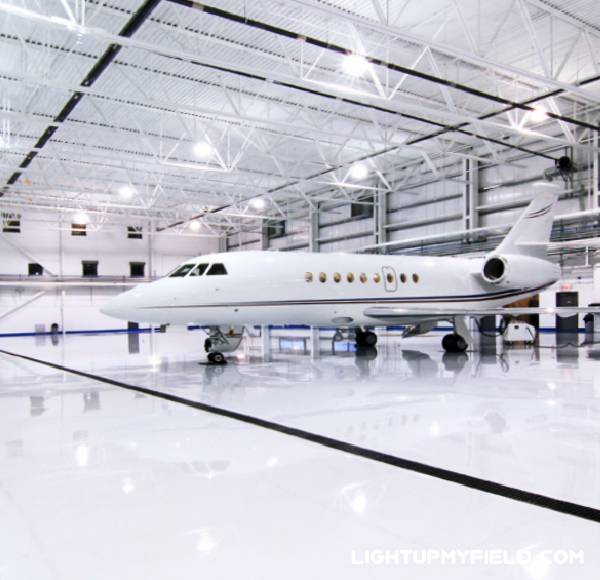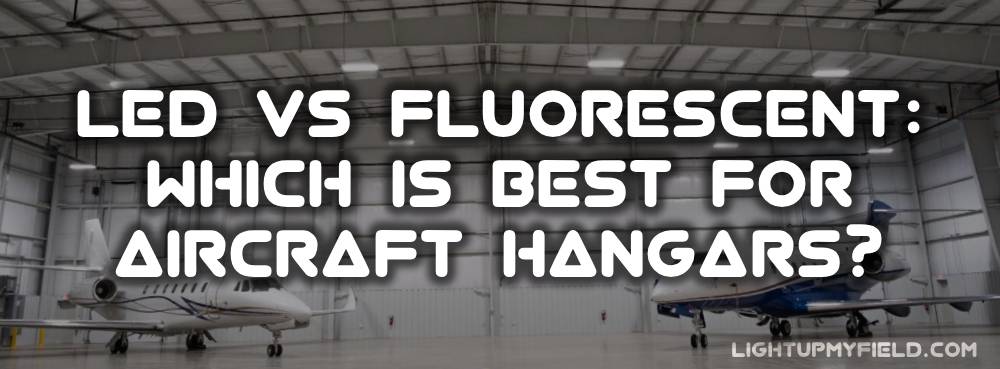When it comes to lighting up aircraft hangars, the choice between LED and fluorescent fixtures pops up a lot. Both have been around for a while, but which one really fits the demanding environment of a hangar? Between energy efficiency, maintenance, brightness, and overall cost, the decision isn’t always straightforward. Let’s dig into the differences and find out what makes each lighting type tick—and which might be the better fit for your hangar space.
Table of Contents
ToggleComparing LED and Fluorescent Lighting
The Basics – What’s Going On Inside?
Let’s kick things off with how these two types of lighting actually work. Fluorescent lights have been around forever in industrial spots like hangars, warehouses, and big workshops. They’re kind of the classic choice because they give decent brightness and don’t cost much upfront. You’ve probably seen those long tubes glowing overhead. Inside, fluorescent tubes pass an electric current through mercury vapor, which then creates ultraviolet light. That UV light hits the phosphor coating inside the tube and voila—you get visible light. Pretty clever, right? But while this was a big upgrade from old-school incandescent bulbs, fluorescent tech isn’t perfect.
One of the quirks is that fluorescents tend to flicker—especially when they’re just switched on or if the temperature dips low. And yes, cold temps in some hangars can cause a delay where the light slowly brightens over several seconds. That flickering and slow start can be a real pain when you want consistent lighting for detailed work. Plus, those mercury vapors mean fluorescent bulbs are a bit tricky to dispose of safely.

How LEDs Change the Game
Now, LEDs—short for Light Emitting Diodes—work on a totally different principle called electroluminescence. Instead of going through mercury vapor, LEDs create light directly by moving electrons through a semiconductor. This means when you flip the switch, LEDs light up instantly to full brightness without any flicker or warm-up time. That makes them super friendly for people who spend long hours staring at tiny aircraft parts or wiring. No eye strain from flickering or fluctuating light levels.
Another thing about LEDs is they’re way more energy-efficient. While a typical fluorescent tube gobbles about 32 watts, an LED tube or fixture that gives you the same or even better brightness might only use 15 to 20 watts. That’s a solid 40-50% drop in energy use per light. Now, picture a big hangar with hundreds of lights running 12 to 16 hours daily—that energy saving isn’t small change. Over a year, it can cut your electricity bill by thousands of dollars, just from swapping to LEDs.
Lifespan – How Long Do They Last?
Here’s a huge deal breaker for a lot of facility managers. Fluorescent bulbs generally last anywhere from 10,000 to 20,000 hours, depending on how often they get switched on and off and the environment they’re in. High ceilings and constant operation can mean more frequent replacements, and climbing up ladders to swap bulbs isn’t exactly anyone’s favorite job.
LEDs completely blow fluorescents out of the water here. Most LED fixtures designed for industrial use are rated for 50,000 hours or more—sometimes even pushing 60,000 to 100,000 hours in premium models. That means fewer replacements, less maintenance hassle, and fewer interruptions for your hangar crews. Over a decade, that could mean replacing fluorescent bulbs three or four times, whereas the LED setup might still be going strong with the original lights.
Light Quality and Other Practical Differences
Brightness isn’t the only thing that matters. LED lights also tend to have a better Color Rendering Index (CRI), which basically measures how accurately colors appear under the light. Fluorescents often have CRI values around 70 to 80, which is okay, but LEDs can push that up to 80-90 or even higher. When you’re dealing with aircraft paint, wiring colors, and tiny mechanical details, better color accuracy helps mechanics spot issues faster and with more confidence.
Also, fluorescent tubes can be sensitive to temperature and humidity swings. Hangars aren’t always climate-controlled, so that can affect how well fluorescents perform over time. LEDs, by contrast, handle cold and hot conditions much better, staying consistent without flicker or dimming.
What About Costs?
Sure, LEDs usually come with a higher upfront price compared to fluorescents. But when you consider energy savings that can cut electricity bills by up to half and the long lifespan reducing maintenance costs, LEDs often end up cheaper over the long haul. Some estimates say you can recoup the higher initial investment in as little as 1 to 3 years, depending on your hangar size and usage patterns.
Plus, with LEDs, there’s a growing range of options with smart controls—like motion sensors and dimming—that make it even easier to save energy during off-peak hours or when certain zones don’t need full lighting.
| Feature | Fluorescent Lighting | LED Lighting |
|---|---|---|
| How It Works | Electric current excites mercury vapor, producing UV light that hits phosphor to make visible light | Electrons pass through a semiconductor to emit light directly (electroluminescence) |
| Start-Up & Flicker | Slow to brighten, flickers especially in cold temps | Instantly bright, no flicker |
| Energy Use | Around 32 watts per tube | About 15-20 watts for same or better brightness (40-50% less energy) |
| Lifespan | 10,000 to 20,000 hours | 50,000 to 100,000+ hours |
| Color Rendering Index (CRI) | Usually 70-80 | Typically 80-90+, better color accuracy |
| Performance in Temperature | Sensitive to cold and humidity, can flicker or dim | Handles cold and heat well, stable performance |
| Maintenance | More frequent replacements, harder in high ceilings | Fewer replacements, less hassle, longer-lasting |
| Upfront Cost | Lower initial price | Higher initial investment |
| Long-Term Costs | Higher energy and maintenance costs | Lower energy bills and maintenance, pays off over time |
| Additional Features | Limited smart controls | Compatible with dimming, sensors, smart tech |
How to Pick the Right LED Hangar Lights
 If you’re leaning toward LEDs—and honestly, most hangar operators are these days—the next step is figuring out exactly what to look for when choosing fixtures. There’s a lot of options out there, so knowing what really matters can save you headaches later.
If you’re leaning toward LEDs—and honestly, most hangar operators are these days—the next step is figuring out exactly what to look for when choosing fixtures. There’s a lot of options out there, so knowing what really matters can save you headaches later.
Brightness and Coverage
First off, brightness is key. It’s usually measured in lumens, which tells you how much light a fixture pumps out. Hangars, especially in maintenance areas, typically need around 500 lux (that’s lumens per square meter). Since these spaces are massive, you’ll want LED fixtures that can produce between 30,000 and 60,000 lumens per unit to cover a good chunk of the hangar without leaving dark corners.
But just grabbing the brightest lights isn’t enough. You need to size and space them properly, so the light spreads evenly. If fixtures are too far apart or too dim, you end up with uneven lighting—some areas bright, others shadowy. And if you cram too many super-bright fixtures too close, glare becomes a problem. It’s a bit of a balancing act to get smooth, uniform illumination that covers every inch without causing eye strain.
Color Temperature – Finding That Sweet Spot
The color temperature of your LEDs also plays a big role in how the space feels and functions. For hangars, aiming for around 4000K to 5000K is a solid bet. That’s the range where the light feels neutral—kind of like natural daylight—making it easier to see details without your eyes getting tired after long shifts.
Going warmer than about 3500K tends to give off a yellowish, cozy glow that might be nice for living rooms, but it actually dulls colors. That’s no good when you’re trying to inspect paint jobs or wiring colors on aircraft. On the flip side, anything above 5500K can feel too harsh and bluish, which some people find fatiguing over time. So sticking to that middle range keeps your crew comfortable and focused.
Color Rendering Index (CRI)
A big deal with hangar lighting is color accuracy, and that’s where the CRI comes in. The Color Rendering Index measures how true colors look under a light source compared to natural sunlight. For aircraft inspections, you want at least an 80 CRI, which means colors appear pretty close to how they do in daylight.
If you want even sharper color accuracy, there are LEDs with CRIs of 90 or higher. They’re pricier but can really help when fine detail and color distinction are vital, like checking paint touch-ups or wiring codes. It’s a trade-off between budget and performance—so pick what fits your priorities.
Energy Efficiency and Controls
Since hangars run lighting for hours on end, energy efficiency is a huge factor. Look for fixtures with a high lumens-per-watt (lm/W) rating—ideally over 120 lm/W. That means more light for less electricity, which adds up to serious savings on your power bill.
Also, think about smart lighting options. Fixtures that are compatible with dimmers or occupancy sensors let you adjust brightness based on what’s happening in the hangar. For example, dim lights during break times or ramp up brightness in inspection bays only when needed. This kind of control helps trim energy costs even further without sacrificing safety or comfort.
Durability for Harsh Hangar Conditions
Hangars aren’t exactly clean rooms—they can be dusty, sometimes humid, and exposed to all kinds of wear and tear. So, durability is a must. Look for LED fixtures rated for tough environments, with IP65 or higher dust and moisture protection. That way, you won’t have to worry about corrosion or dirt gumming up your lights, which could kill their performance and lifespan.
A rugged fixture also means fewer repairs and replacements, saving you time and money on maintenance—something every hangar manager appreciates.
Glare Control and Light Distribution
Last but not least, think about how the light spreads and whether it causes glare. LED fixtures come with various optics or lenses designed to control beam angles and soften light distribution. Good optics can help spread light evenly across the floor and aircraft surfaces while cutting down on harsh reflections.
Since aircraft bodies are shiny and reflective, harsh direct light can create annoying glare that makes it tough for mechanics to see details properly. Fixtures designed to reduce glare not only improve visibility but also reduce eye fatigue over long work shifts.
Conclusion
When it comes to lighting aircraft hangars, LEDs generally offer a better blend of efficiency, light quality, and durability compared to fluorescent lighting. While fluorescent lamps may still be found in some older hangars due to lower upfront costs, the long-term savings and improved working conditions provided by LEDs usually tip the scale.
If you want lighting that stays bright and true, saves energy, and makes life easier for maintenance crews, LED is the way to go. It’s a smart investment that pays off over time, helping keep the hangar safe, well-lit, and ready for the tough tasks that happen day in and day out.

